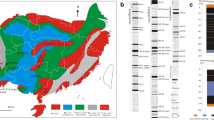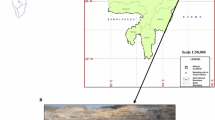Abstract
Inductively coupled plasma mass spectrometry, inductively coupled plasma optical emission spectroscopy, hydride generation-atomic fluorescence spectrometry, emission spectrometry, X fluorescence spectrometry, and X-ray diffraction were employed to study the geochemistry and mineralogy of coal gangues from Nos. 2, 3, and 8 coal seams of the Du’erping coal mine, Xishan coalfield, Taiyuan, Shanxi Province. The study revealed that compared with the sedimentary cover, upper continent crust, Carboniferous-Permian coal from North China, as well as most coal in China, coal gangues from Nos. 2 and 3 coal seams are rich in Li, Be, Sc, Cr, Cu, Ga, Ba, Th, Nb, Cd, Pb, Ta and rare-earth elements, and coal gangues from No. 8 coal seam are rich in Li, Sc, V, Cr, Ga, U, and rare-earth elements. Compared with the Carboniferous-Permian coal from North China and most coal in China, coal gangues from Nos. 2, 3 and 8 seams are rich in Rb, V, Cs and Sr. Therefore, The Du’erping coal gangues in the Xishan coalfield are rich in most hazardous trace elements and rare-earth elements, wherein the contents of Ga and Li reach the industrial grade and have significance for industrial utilization. On the whole, coal gangues of the Shanxi Formation from the Permian are rich in more trace elements than those of the Carboniferous Taiyuan Formation. The distributions of REE show obviously dipping rightwards with negative Eu anomalies. The contents of rare-earth elements in the three seams are quite different. All of the above indicate that the source of the rare-earth elements is terrigenous debris. Minerals in No. 2 seam identified by X-ray diffraction mainly include quartz, kaolinite, in addition to calcite, pyrite, apatite, epidote, and epsomite. No. 3 seam mainly contains quartz, kaolinite, in addition to a small amount of sodium feldspar, calcium nitrate, iron ore, gypsum, and vivianite. No. 8 seam mainly contains kaolinite, dickite, quartz, illite, and a small amount of hematite and U. The correlations between major elements and trace elements in coal gangues of the Du’erping coal mine analyzed by using SPSS (Statistical Product and Service Solutions) indicate that the trace alkali elements and rare-earth elements occur mainly in such clay minerals as kaolinite.
Similar content being viewed by others
References
Bouka V., Peek J., and Sykorova I. (2000) Probable Modes of Occurrence of Chemical Elements in Coal [M]. Acta Montana, Ser B. Fuel, Carbon, Mineral Process, Praha. 10, 53–90.
Brownfield M.E., Affolter R.H., Strieker G.D., and Hildebrand Ricky T. (1995) High chromium contents in Tertiary coal deposits of northwestern Washington-A key to their depositional history [J]. International Journal of Coal Geology. 27, 153–169.
Chi Q. and Yan Mingcai (2007) Date Handbook of Applied Geochemical Elemental Abundance [M]. pp.153–169. Geological Press, Beijing.
Dai Shifeng, Ren Deyi, Chou Chenlin, Robert B. Finkelman, Vladimir V. Seredin, and Zhou Yiping (2012) Geochemistry of trace elements in Chinese coals: A review of abundances, genetic types, impacts on human health, and industrial utilization [J]. International Journal of Coal Geology. 94, 3–21.
Dai Shifeng and Jiang Yaofa (2012) Mineralogical and geochemical compositions of the coal in the Guanbanwusu Mine, Inner Mongolia, China: Further evidence for the existence of an Al (Ga and REE) ore deposit in the Jungar coalfield [J]. International Journal of Coal Geology. 98, 10–40.
Dai Shifeng, Ren Deyi, Li Shengsheng et al. (2003) Concentrations of minor elements and regional distribution of arsenic in Late Paleozoic coals from North China Platform [J]. Journal of China University of Mining & Technology. 32, 111–114 (in Chinese with English abstract).
Dai Shifeng, Ren Deyi, and Li Shengsheng (2006) The discovery of Zhun Ge Er ultra large gallium deposit in Inner Mongolia [J]. Chinese Science Bulletin. 51, 177–185 (in Chinese).
Dai Shifeng, Ren Deyi, and Tang Yuegang (2005) Modes of occurrence of major elements in coal and their study significance [J]. Coal Geology and Exploration. 33, 1–4 (in Chinese with English abstract).
Dang Zhi, S.F. Watts, and Martin Haigh (1996) Kinetics of coal mine spoil-water interaction—II. Mineralogical study on trace metal elements in coal gangue [J]. Science in China (D: Earth Sciences). 26, 16–20.
Ministry of Land and Resources, the People’s Republic of China (2002) Specifications for Rare-metal Mineral Exploration [S]. Geological Press, Beijing (in Chinese). DZT/0203-2002.
Ministry of Land and Resources, the People’s Republic of China (2006) DZ0130-2006, Quality Management Specifications for Laboratory Testing of Geological Mineral Resources [S]. Geological Press, Beijing (in Chinese).
Finkelman R.B. (1994) Modes of occurrence of potentially hazardous elements in coal: Level of Confidence [J]. Fuel Proeessing Technology. 39, 21–34.
Finkelman R.B. (1995) Modes of occurrence of environmentally-sensitive trace elements in coal. In (eds. Swaine D.J. and Goodarzi F,) Environmental Aspects of Trace Elements in Coal [M]. Dordrecht: Kluwer Academic Publishers, 24–50.
Li Zhaolong (2010) Study on Intrusive Characteristic & Tectonic Environment of the Huyan Mountain Alkaline Complex in Jiaocheng, Shanxi Province [D]. pp.25–29. Taiyuan University of Technology, Taiyuan.
Ling Qicong and Liu Congqiang (2001) Behavior of rare-earth elements in fluid-rock interaction: A review [J]. Acta Mineralogica Sinica. 21, 107–114 (in Chinese with English abstract).
Liu Chaohui, Liu Shuwen, Liu Qiuyin et al. (2005) Origin on the Luyashan Early Proterozoic charnockite geochemical and isotopic evidence [J]. Progress in Natural Science. 11, 1374–1382.
Liu Yingjun and Cao Liming (1987) Elements Geochemistry Introduction [M]. Geological Publishing House, Beijing.
Ren Deyi, Zhao Fenghua, Wang Yunquan, and Yang Shaojin (1999) Distribution of minor and trace elements in Chinese coals [J]. International Journal of Coal Geology. 40, 109–118.
Rimmer S.M. (1991) Distributions and association of selected trace elements in the Lower Kittanning seam, western Pennsylvania, USA [J]. International Journal of Coal Geology. 17, 189–212.
Shao Jingbang, Zeng Fangui, Wang Yulin, and Gao Changqing (1997) Geochemical characteristics of rare-earth elements in coal from the Pingzhuang coalfield [J]. Coal Geology & Exploration. 25, 13–16 (in Chinese with English abstract).
Swaine D.J. and Goodarzi F. (1995) Environmental Aspects of Trace Elements in Coal [M]. pp.1–312. Kluwer, Academic Publishers.
Tang Xiuyi and Huang Wenhui (2004) Trace Elements in Coal of China [M]. pp.1–28. The Commercial Press, Beijing.
Taylor S.R. and McLennan S.M. (1985) The Continental Crust: Its Composition and Evolution [M]. pp.312. Blackwell, Oxford.
Wang Xinyi, Yang Jian, and Guo Huixia (2006) Study on heavy metals in soil contaminated by coal waste rock pile [J]. Journal of China Coal Society. 31, 808–812 (in Chinese with English abstract).
Yang Qi, Pan Zhigui, Weng Chengmin, Su Yuchun, and Wang Zhengping (1988) Metamorphic Characteristics and Geological Causes of Permo-carboniferous Coal in North China [M]. pp.61–66. Geological Publishing House, Beijing.
Zhang Chunmang (2000) Analysis of relationship between coal series clay minerals and coal metamorphism [J]. Industrial Minerals & Porocessing. 9, 19–21 (in Chinese with English abstract).
Zhang Li, Han Guocai, Chen Hui, Ma Mingguang, and Guo Hongdong (2008) Study on heavy-metal contaminants in soil come from coal mining spoil in the loess plateau [J]. Journal of China Coal Society. 33, 1141–1146 (in Chinese with English abstract).
Zhou Anchao, Jia Bingwen, Ma Meiling, and Zhang Hui (2001) The whole sequences of volcanic event deposits on the north margin of the North China plate and their features [J]. Geological Review. 47, 175–184 (in Chinese with English abstract).
Author information
Authors and Affiliations
Corresponding author
Rights and permissions
About this article
Cite this article
Wen, X., Zeng, F. & Zhang, H. Geochemical characteristics of the coal gangues from the Du’erping coal mine, Xishan coalfield, North China. Chin. J. Geochem. 32, 227–234 (2013). https://doi.org/10.1007/s11631-013-0626-2
Received:
Accepted:
Published:
Issue Date:
DOI: https://doi.org/10.1007/s11631-013-0626-2




